nonGeographicDataset
Type of resources
Available actions
Topics
INSPIRE themes
Provided by
Years
Formats
Update frequencies
status
-

UNO is a underwater images dataset allowing deep-learning networks to localize non-natural objects within underwater images. The dataset consists in 279 videos, 5930 frames, and 10809 labels. UNO is a more consistent and balanced version of the TrashCan image dataset to evaluate models for detecting non-natural objects in the underwater environment. We propose a method to balance the number of annotations and images for cross-evaluation. We then compare the performance of a SOTA object detection model when using TrashCAN and UNO datasets. Additionally, we assess covariate shift by testing the model on an image dataset for real-world application. Experimental results show significantly better and more consistent performance using the UNO dataset.
-
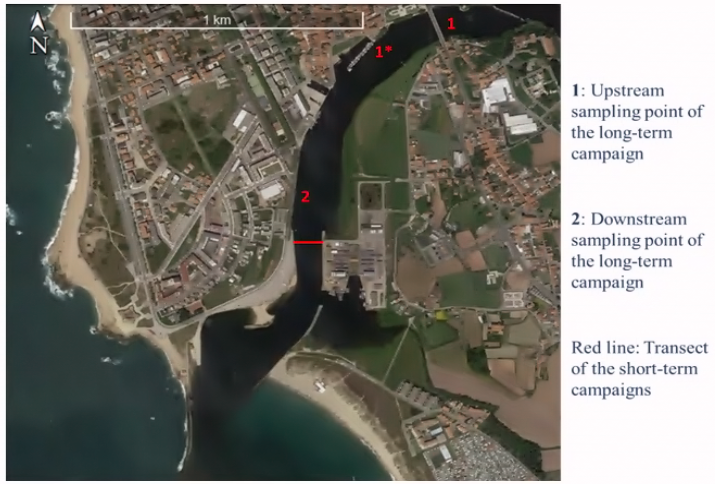
A bubble Barrier that removes litter from rivers is being applied in the Ave estuary (Portugal) in the framework of the MAELSTROM Project. In order to identify the location where the technology could possibly best be applied and to assess the impact of the litter removal on marine life, MAELSTROM makes use of numerical models. Facing the limited field data and absence of available models, we carried out field campaigns, set-up a hydrological model for the Ave river basin and set-up a hydrodynamic model for the estuarine region. The field studies included a bathymetric survey, short-term (12.5 hours) and long-term (several weeks) campaigns. Aiming to understand the temporal and spatial variation of the flow velocity in the estuary, and particularly in the area where the Bubble Barrier system is planned to be implemented, we have analysed observations from a boat sailing across the estuary (short-term), we have analysed observations at selected locations (long-term) and we have set-up a 3-dimensional (3D) hydrodynamic model to give insight in the flow velocity distribution. Only during the short-term campaigns the river discharge is known, which was relatively low during these campaigns. Since the river discharge is an important condition for the hydrodynamic model, we have only obtained maximal flow velocity maps for low river discharge. For higher river discharge we show a maximal flow velocity observed during a long-term campaign and we estimate maximal flow velocity based on an extreme river discharge.
-
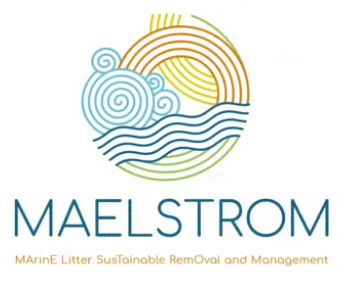
New solutions for the recovery of marine plastics and litter: The global marine plastic litter challenge comprises an estimated stock of 83 million tonnes of plastic waste accumulated in oceans. The recovery of plastic materials already in the ocean is an arduous and costly task. This is why innovations are urgently needed. The EU-funded MAELSTROM project is bringing together key stakeholders – from research centres and recycling companies to marine scientists and robotic experts – to leverage the integration of complementary technologies for the sustainable removal of marine litter in different European coastal ecosystems. The project will design, manufacture and integrate scalable, replicable and automated technologies, co-powered with renewable energy and second-generation fuel, to identify, remove, sort and recycle all types of collected marine litter into valuable raw materials. Objective: MAELSTROM strives to provide answers and diversified solutions to the complex question to the removal and sustainable treatment of marine litter legacy. MAELSTROM leverages on the integration of complementary technologies for marine litter removal in different European coastal ecosystems, compounded with full-fledged circular economy and societal oriented solutions. In particular, the project (i) sets out a reliable multidisciplinary and scientifically sound approach for the assessment of marine debris distribution and impact on marine life in highly valuable ecosystems and protected areas; (ii) designs and manufactures scalable, replicable and automated technologies, co-powered with renewable energy and second generation fuel, to identify, remove and sort marine litter; (iii) evaluates over time the effectiveness of marine litter removal devices along with their impact on local ecosystems; (iv) integrates different technologies to track, sort and recycle all types of collected marine litter into valuable raw materials for future marketisation; (v) assesses the economic and societal impact of the MAELSTROM solutions providing also a comprehensive life-cycle assessment of the technologies and products; (vi) enhances social awareness about the marine litter issue and engages citizens and stakeholders in MAELSTROM activities; (vii) interplays with similar projects to maximize innovation uptake for marine litter removal within and outside the EU. MAELSTROM is formally supported by a set of key stakeholders committed to sustain its core actions and its follow up activities. The consortium is a tight knit group made of research centers and foundations of excellence in marine life, biology and sustainable energy, AI and robotics, multinational /national recycling companies with certified industrial plants, a market consultancy company, a micro-enterprise and a plastic-focussed NGO.
-
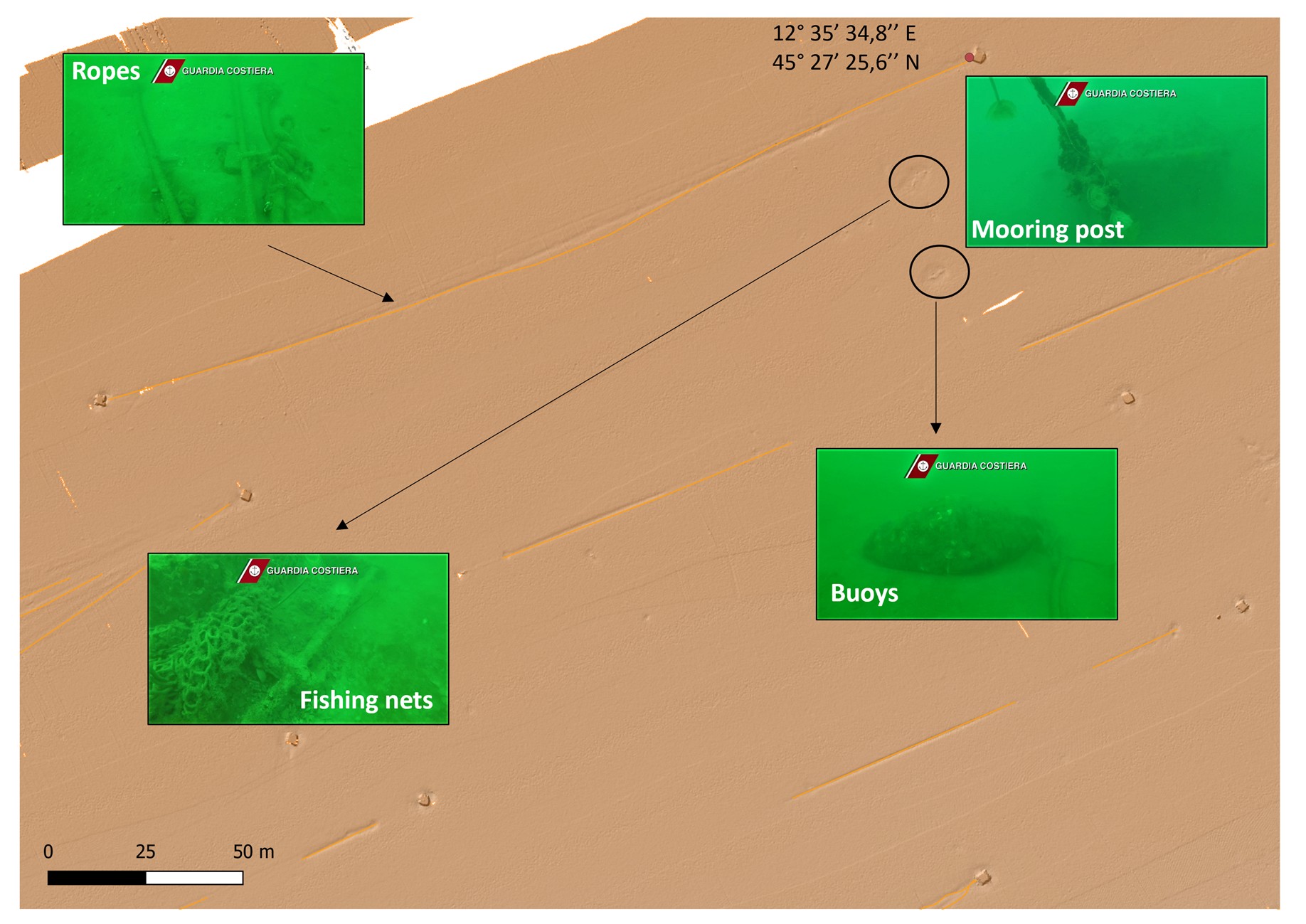
As part of the MAELSTROM project, a video survey was conducted on 23 September 2022 at the abandoned mussel farm (MF) site in the coastal area outside the Venetian lagoon. The purpose of the survey was to visually document and classify marine debris items on the seabed and to support the validation of previous bathymetric analyses. The inspection revealed several types of debris, including mooring structures, ropes, and derelict fishing gear, elements that are often challenging to detect through remote sensing techniques alone.
-

One of the aim of the MAELSTROM project was to provide a new set of integrated and advanced solutions to identify the typology of marine litter and foremost its traceability from the collection to the treatment phase through innovative app and portal. The Project developed a software and hardware tracking platform for ML data mining and sharing to narrate the in-field organization and testing of marine litter tracking, monitoring and clean up activities. The campaign conducted by Venice Lagoon Plastic Free (VLPF) of marine litter monitoring in the lagoon of Venice in Italy was devised to provide guidance and the feedback required to instruct the technical team's work involved in framing, developing, and fine-tuning the marine litter monitoring service within the MAELSTROM app. The dataset represents the results of four beach litter surveys conducted in the area of the Venice Lagoon in 2021. Data report the number of items identified on the beaches in a 100 m long transect along the beach length. The typology of items is identified using the “G code”, as per the Guidelines and forms for gathering marine litter data: beach and seafloor trawling (Galgani et al., 2021). For more information about the survey see the project deliverable 6.1.
-
In the Ave River estuary, monitoring of Floating Macro-Litter (FML) was undertaken before (June 2021 - December 2023) and after the installation of the Bubble Barrier remediation technology in order to assess its effectiveness. Evaluation of FML followed standard European guidelines (Hanke et al., 2013, 2023) and was conducted through visual monitoring to assess the diversity and relative abundance of debris in the area. Monitoring campaigns were carried out monthly from June 2021 to December 2024. FML observations were performed using binoculars (during ebb tide at three designated locations in the estuary—downstream, midstream, and upstream. All three observation points were positioned at the same elevation along the estuary margin, approximately 2 meters above the water surface (mean sea level), ensuring a consistent viewing angle for reliable comparisons between locations. Although some FML objects may have been partially obscured by wind-generated ripples or small waves from passing boats, this impact was minimized as observations were conducted on calm days with high visibility. More details on the methodology can be found in D5.4 More details on the results can be found in D2.4.
-
After the installation and launch of the Bubble Barrier system at the end of 2023, the litter collected in the catchment system was evaluated monthly from January to December 2024. More details on the results can be found in D5.4.
-
An acoustic survey was carried out on 11 November 2024 to measure the noise impact of the Bubble Barrier technology in the Ave River estuary. This analysis, initially not foreseen by the project, was introduced to provide some preliminary background information on the possible impact from noise pollution on aquatic species. A recently calibrated ICListen high-frequency hydrophone was used to provide absolute measures of biotic, abiotic and anthropogenic sound levels to draw meaningful comparisons of habitats through time and at different locations. The survey encompasses the sampling at three different locations at the margin of the estuary (piers), the first one at the centre river-side of the Bubble Barrier pier, second on the corner of a small pier near the end of the Bubble Barrier, 285 m from the centre of the Bubble Barrier pier, and the last one at the end of a yacht pier, 628 m from the centre of the Bubble Barrier pier. The hydrophone was lowered into the water tied to a line and placed about 50 cm above the estuary bottom for recording. Recordings of at least 5 minutes were taken with the Bubble Barrier switched off and on at all piers and during the start of the Bubble Barrier at Pier 1. For the comparison of conditions with the Bubble Barrier switched on and off, recorded minutes without exceptional noise events were selected to represent base noisescapes. More details on the methodology can be found in D5.4
-
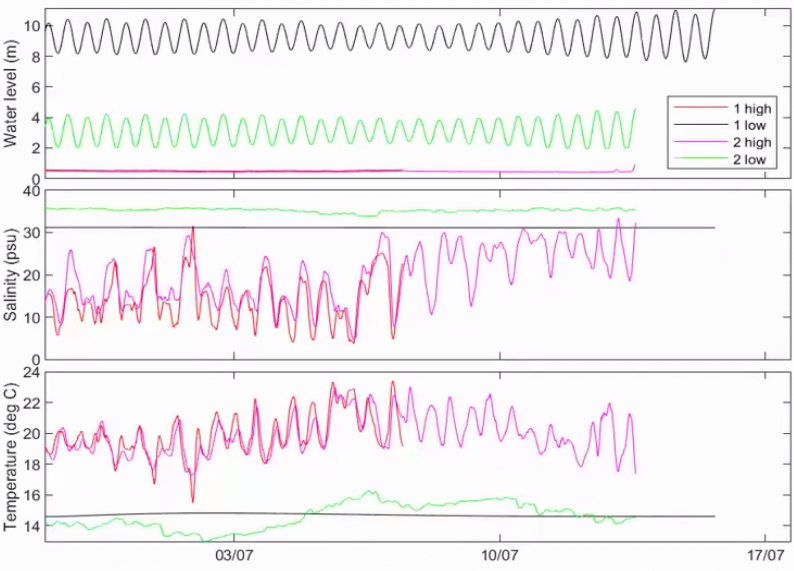
Both the short-term and long-term campaigns were performed during summer and winter conditions, meaning respectively a low and high river discharge. For the long-term campaigns, instruments were deployed for several weeks: CTD and ADCP.
-
In the framework of the MAELSTROM Project, several activities were performed to achieve the implementations of the Software portal and MAELSTROM app developed for the tracking of marine litter: The Marine Litter Monitoring Campaign in Italy 1. St. Pietro in Volta beach 2. Portosecco beach 3. The Island of Lazzaretto Nuovo in Venice 4. The Island of Pellestrina The Marine Litter Monitoring Campaign in Portugal 5. The Cabedelo Beach The Marine Litter Clean Up operated with the MAELSTROM app 6, The island of Madonna del Monte 7. The island of Saint Erasmo 8. The island of Bacan 9. The beach of Portosecco in the island of Pellestrina The Marine Litter Clean Up Campaign in Venice (Italy) 10. The island of Lazzaretto Nuovo 11. The Island of Madonna del Monte clean up 12. The island of Saint Erasmo clean up 13. The island of Bacan clean up (I) 14. The island of Bacan clean up (II) The Marine Litter Clean up campaign in Portugal 15. Castelo do Queijo beach Clean up (18/09/2021) The activities performed to test the services (Marine litter monitoring activities, Marine Litter Clean up activities and Marine Litter tracking) implemented through the Maelstrom App and Portal are described in the Deliverable 6.1 (restricted).
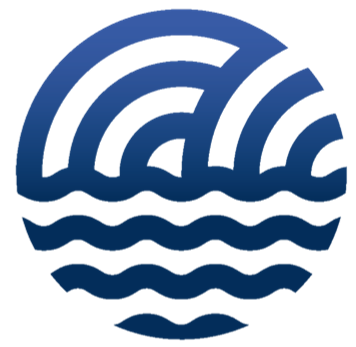 CNR-ISMAR
CNR-ISMAR